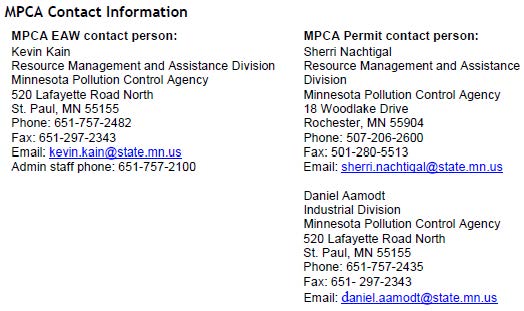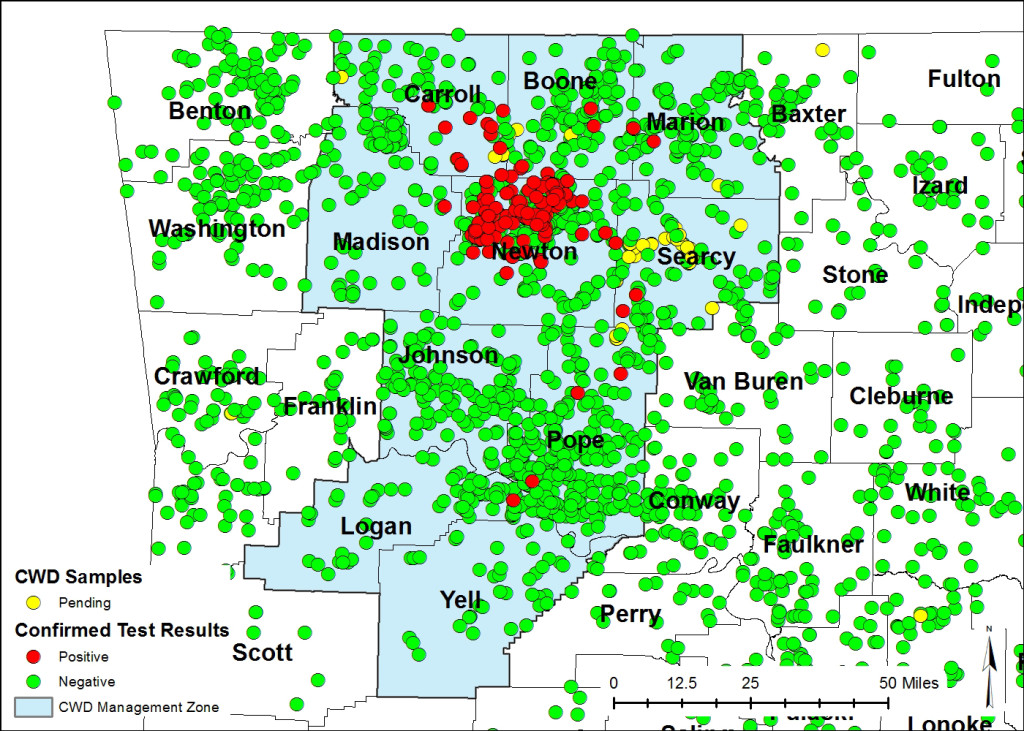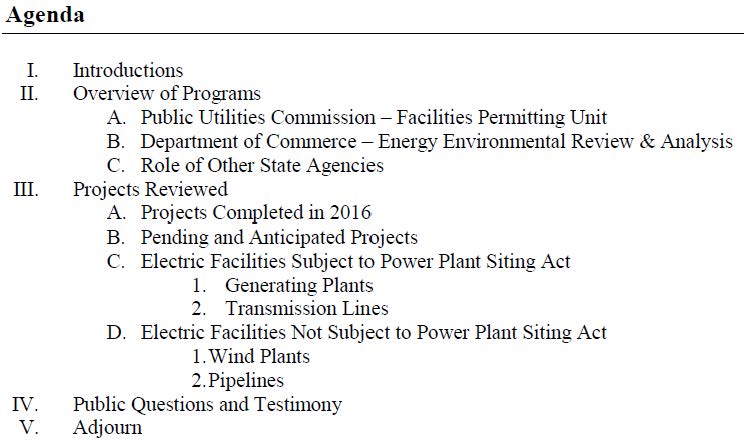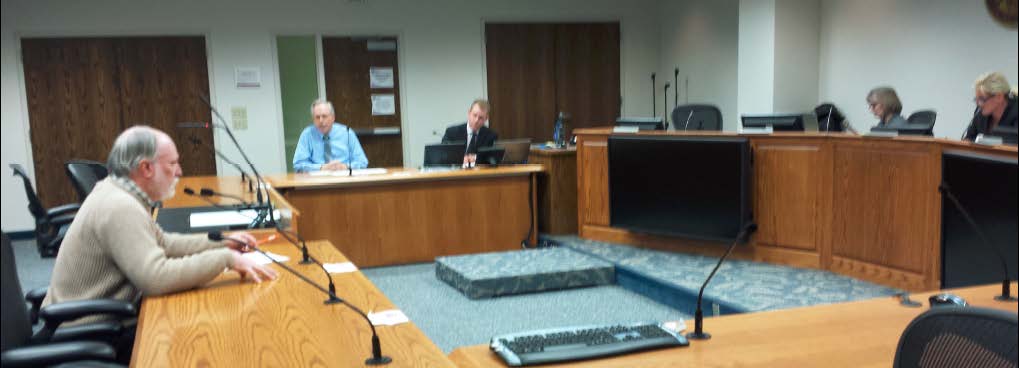Hey Red Wing — MPCA’s Lab USA documents here!
December 30th, 2016
Here’s the EAW — Comments are due by January 4, 2017:
Send Comments to (click for larger image):
These are the documents I’ve received from the MPCA thus far. There’s a lot and I’ll be uploading today:
Lab USA Permit Application
June 16 Permit Application-Part 1 Checklists
June 16 Permit Application Part 2 Design-Rep
Lab USA Documents
SW 670
2025947-212729-Lab USA Stmt of Authority
2062890-212729-Corresp Lab USA – Permit App Amendments
1906244-212729-Corresp 7/20/2016 – MPCA – Technical Comments
2025941-212729-public-sw-670-Corresp SEH Permitting Responses
More CWD (chronically wasted deer) in MN
December 30th, 2016

It’s old news, be it “mad cow” or “sheep scrapie” or “pissy deer” a/k/a Bovine Spongiform Encephalopathy (BSE), Chronic Wasting Disease (CWD), and it’s here in Minnesota, this time the DNR reports another round of CWD revealed in deer:
Here’s the DNR’s page on chronically wasted deer:
Notice the DNR is talking about “management” and not prevention and eradication.
As a former meat hauler, and as a for-the-most-part veggie, I noticed years ago when a local man died of Jakob-Creutzfeld (don’t know if it was “variant” or not, that was not reported one way or the other), and have been waiting for the other shoe to drop. It did later, when three Wisconsin men died of Jakob-Creutzfeld — the Center for Disease Control is paying attention (but not nearly enough):
Fatal Degenerative Neurologic Illnesses in Men Who Participated in Wild Game Feasts
Not just Minnesota and Wisconsin –here’s the US map (linked) — what concerns me is that it looks like only the Fillmore County and that the Pine Island CWD cases aren’t shown, where deer and elk were found, an entire elk herd shot: :
:
Here’s bad news from Arkansas, lots of bad news:
Yearly Archives: 2016
Creutzfeld-Jakob variant – 4th declared case
June 6th, 2014
Chronic Wasting Disease in Minnesota Deer
January 21st, 2011
2016 PPSA Annual Hearing
December 23rd, 2016
Tuesday was the Annual Hearing for the Power Plant Siting Act. I’ve been fighting off this sickness that Alan’s had for a week now, and not quite feeling right, more like life inside a pillow, everything’s rather dampened. But I slogged out into the world, and raised a few of the recurring points, issues with the Power Plant Siting Act, particularly public participation issues common not just to the Power Plant Siting Act (Minn. Stat. Ch. 216E ), but also to wind siting dockets under Minn. St. Ch. 216F, and pipeline routing dockets under Minn. St. Ch. 216G.
Here’s how to submit comments, deadline January 20, 2017:
Until this year, the Power Plant Siting Act Annual Hearing has included a review, rundown, listing, of all the projects approved by the Commission, including wind and pipelines, and this was anticipated at this hearing per the notice:
The full Notice:
HOWEVER… that report, “Projects Reviewed” section D, “Electric Facilities Not Subject to Power Plant Siting Act, did not occur. I’d guess in large part it was due to the many issues raised by those intervening and participating, or attempting to participate, in wind siting dockets who have appeared at PPSA Annual Hearings over the years. And I’m sure they did not want input from those participating and intervening in pipeline dockets, we’ve seen how Enbridge cancelled their “public informational meetings” up north after having to face the public and their legitimate issues the day before in Bemidji. Alan Mitchell, formerly EQB PPSA staff, and now working for Enbridge, was there, so this was on Enbridge’s radar, but of course, that Alan didn’t have any comments for the record (I do wish I remembered more about the pipeline rules rewrite that he worked on during his time at the EQB, I think somewhere around 2002-2004?).
The ALJ is to write a summary of the Comments, both at the meeting, and those filed afterwards, and then? What happens? Experience says “not much.” PUC staff responded to the “What happens” question saying that things that don’t require statutory changes or rulemaking, that those are things they want to impliment, to change, to improve, and to the extend that we can, we implement. So he said. When the report comes from the ALJ, they review it, they’ll have the transcript from this meeting, and will go over it.
There was a pretty crowded room, better attendance than for the last couple of years, with two new members of the public speaking up. John Munter, who has been very active in opposition to the Sandpiper and now the Line 3 “replacement” pipeline issues, spoke about the difficulties of participating in the dockets, the difficult to untangle web of “need” and “route” dockets, and of the many pipeline projects ongoing. Tina Carey spoke of the issues she and her neighborhood encountered during construction of the massive “largest in Minnesota” solar project that went up across the street, and that the complaint process was insufficient and ineffective, and the neighborhood’s complaints were disregarded. Cynthia Warzecha, of the DNR, gave a solid synopsis of DNR activities in PPSA dockets, and I’ll note that the DNR and DOT have really gotten into the groove of reviewing projects and providing material and substantive comments for consideration, in the EIS and in the route or siting docket (and also in environmental review in Certificate of Need dockets). Kristen Eide-Tollefson spoke as an individual with a 20 year history as a participant in routing and siting dockets, and noted for the record this legislative prelude to the transfer of environmental review from the EQB to the Dept. of Commerce:
2005 Session — Chapter 97, Article 3, lays out the purpose for transfer from EQB to PUC and DOC, of responsibilities for Siting, Routing and Environmental Review.Environmental Review. Sec. 17. To ensure greater public participation in energy infrastructure approval proceedings and to better integrate and align state energy and environmental policy goals with economic decisions involving large energy infrastructure, all responsibilities, as defined in Minnesota Statutes, section 15.039, subdivision 1, held by the Environmental Quality Board relating to power plant siting and routing under Minnesota Statutes, sections 116C.51 to 116C.69; wind energy conversion systems under Minnesota Statutes, sections 116C.691 to 116C.697; pipelines under Minnesota Statutes, chapter 116I; and rules associated with those sections are transferred to the Public Utilities Commission under Minnesota Statutes, section 15.039, except that the responsibilities of the Environmental Quality Board under Minnesota Statutes, section 116C.83, subdivision 6, and Minnesota Rules, parts 4400.1700, 4400.2750, and 4410.7010 to 4410.7070, are transferred to the commissioner of the Department of Commerce. The power plant siting staff of the Environmental Quality Board are transferred to the Department of Commerce. The department’s budget shall be adjusted to reflect the transfer.
2006 Report to PUC – Docket 06-1733
2007 Report to PUC – Docket 07-1579
2008 Report to PUC – Docket 08-1426
2009 Report to PUC – Docket 09-1351
2010 Report to PUC – Docket 10-222
2011 Report to PUC – Docket 11-324
2012 Report to PUC – Docket 12-360
2013 Report to PUC – Docket 13-965
2014 Summary Comments– Docket 14-887
2015 Summary Report – Docket 15-785
Drumpf’s “Questionnaire” to Dept. of Energy
December 9th, 2016
Trump’s energy agenda, vague as it is, has been essentially to promote “clean coal,” nuclear and to deny climate change and dismantle federal climate change and “renewable” energy programs, of course with no move to eliminate subsidies for coal and nuclear. The “transition team” sent a big laundry list of questions to the Department of Energy, and it’s pretty broad. It’s also something that would be both telling and intimidating to receive. Looking at this, there’s no doubt where they’re headed.
Here’s the document — read it and see what you think… and note how many of these questions are “Can you provide…” which are easily answered with just a “Yes” or “No” and that’s the end of it!
But wait… there’s another version (similar, but different order, etc.):
I think Trump needs somebody to write his questions for him, somebody new that is. He obviously didn’t come up with this, but his staff person who did, well, if they worked for me, “YOU’RE FIRED!”
LTE in Dodgeville Chronicle
December 8th, 2016
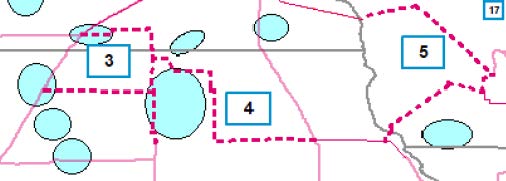
See the lower 1/2 of MISO’s MVP project 5, running from near Dubuque, IA to the northeast to the “Cardinal” substation near Madison? That’s the Cardinal – Hickory Creek transmission line.
The Dodgeville Chronicle ran my Letter to the Editor, just in time for the meeting last night, held by Rural Utilities Service, about the Cardinal – Hickory Creek transmission project:
Carol A. Overland, Esq.
Red Wing, MN

